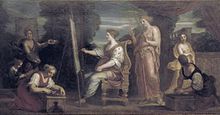Iaia of Cyzicus, sometimes (incorrectly) called Lala or Lalla,[a] was a Roman painter, alive during the time of Marcus Terentius Varro (116–27 BC).
Born in Cyzicus,[3] she was a famous painter and ivory engraver. Iaia likely came to Rome to meet the demand for art there in the late Republic.[4] Most of her paintings are said to be of women. Pliny attributes to her a large panel painting of an old woman and a self-portrait. She was said to have worked faster and painted better than her male competitors, Sopolis and Dionysius, which enabled her to earn more than them. Iaia remained unmarried all her life.
Influence on culture
Literature
Iaia is one of the five female artists of antiquity mentioned in Pliny the Elder's Natural History (XL.147–148): the others are Timarete, Irene, Aristarete, and Olympias.[5] Iaia is one of three women artists mentioned in Boccaccio's De mulieribus claris.[6] The character of Julie Lambert, protagonist of the novel "Shining harmony" (2017), and of the poetic anthology "Living and not living" (2018), both by Italian writer Sabrina Gatti, was inspired by Iaia di Cizico. In the novel, Julie, a talented painter, sees in Iaia the artist to emulate, and dedicates to her a painting where she portrays the Roman painter, intent on painting in her atelier; while in "Living and not living", the young woman is completely identified with Iaia.
Art
Iaia (as Lalla) is one of the names featured on Judy Chicago's Heritage Floor.[7]
Notes
References
- ^ Baldwin, Barry (1981). "Germaine Greer and the Female Artists of Greece and Rome". Échos du Monde Classique. 25. n. 7.
- ^ Yiu, Yvonne (2005). "The Mirror and Painting in Early Renaissance Texts". Early Science and Medicine. 10 (2): 189.
- ^ Commire, Anne, ed. (2002). "Iaia (fl. c. 100 BCE)". Women in World History: A Biographical Encyclopedia. Waterford, Connecticut: Yorkin Publications. ISBN 0-7876-4074-3. Archived from the original on 2018-09-23.
- ^ "Painting, Roman". Oxford Classical Dictionary (4 ed.).
- ^ Corbeill, Anthony (2017). "A New Painting of Calypso in Pliny the Elder". Eugesta Revue. 7.
- ^ Borzello, Frances. Seeing Ourselves: Women's Self-Portraits. p. 42.
- ^ "Lalla". Brooklyn Museum. Retrieved 10 July 2019.
- Helen Gardner, Fred S. Kleiner, Christin J. Mamiya, Gardner's Art Through the Ages, Thomas Wadsworth, 2004; ISBN 0-15-508315-5.
- Pliny the Elder, Natural History, 35.40,147.L
- Virginia Brown's translation of Giovanni Boccaccio’s Famous Women, pp 135 – 137; Harvard University Press, 2001; ISBN 0-674-01130-9
- Harris, Anne Sutherland and Linda Nochlin, Women Artists: 1550-1950, Los Angeles County Museum of Art, Knopf, New York, 1976, pg. 23.

